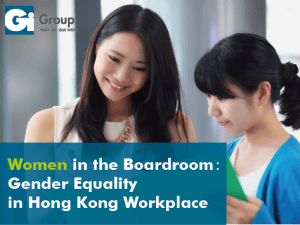
“If they don’t give you a seat at the table, bring a folding chair.”
Shirley Chisholm, first African-Amercian woman elected to the US Congress
Notwithstanding the advancement in educational opportunities in the last few decades, Hong Kong women still lag behind men in terms of economic participation and employment earnings, as well as their representation in top executive and professional roles.
Only 55% of women are in the workforce in Hong Kong, which is lower than Singapore (60.5%), Australia (60.6%), Mainland China (61.4%), and Japan (69.7%). The low labor force participation rate is partially attributed to the entrenched gender biases, the lack of work-life balance and women’s inherited role as primary careers.
Working mothers in Hong Kong confront prejudice at work and pressure to bear the caring responsibility. Fewer than half of the local employers would hire women with children even though they are as experienced and skilled as their companions. In 2020, the number of economically inactive women is 1.6 times that of men. Among the women who are out of work, 37% claimed they dropped out of the workforce because of the responsibility to engage in household duties, as compared to 3% of men who claimed so. The challenge comes from the inadequate support for working mothers. At the end of 2020, the Government has extended the maternity leave under the Employment Ordinance from 10 weeks to 14 weeks.
The gender wage gap in Hong Kong stands at 22%, considerably wider than Singapore (11.8%). Only one third of management is female, which is significantly behind Malaysia (38%) and Mainland China (37%). Among the 50 Hang Seng index constituent companies, women occupy just 13.6% of board positions and 11 HSI listed organizations hold all-male boards. In comparison, the figure stands at 25.3% in Malaysia and 18.4% in Singapore. In the meanwhile, women make up 33.5% of FTSE 100 board members in the UK and 28.6% of S&P 100 boards in the US. India mandates that at least one woman be on a board, and nearly 16% of directors there are female. The value of board diversity precisely influences business performance. The research by Bayes Business School in London reveals that meeting rooms with female representation no less than 30 % outperform all-male boards over both the short and long term.
Female leadership styles and traits, such as empathy and self-awareness, are particularly appreciated now more than ever to help organizations recover and emerge stronger from the pandemic. Everyone has a part to play to drive gender diversity and ensure greater inclusion in the workplace, specifically the Human Resources industry. HR professionals should be dedicated to challenge unfair practices and drive long-lasting change in the labor force, through anti-discriminatory policies, the adoption of technological solutions and algorithms, and advocating gender equality in the organizational culture.
References:
- Women and Men in Hong Kong Key Statistics (2021 Edition), Census and Statistics Department, HKSAR
- “Hong Kong and Gender Equality.” The Women’s Foundation, twfhk.org/blog/hong-kong-and-gender-equality.
- “Extended Maternity Leave Explained.” Hong Kong’s Information Services Department, 4 Dec. 2020, www.news.gov.hk/eng/2020/12/20201204/20201204_111608_107.html.
- Ko, Teresa. “Hong Kong Is Falling behind on Gender Diversity.” Financial Times, Financial Times, 4 Mar. 2020, www.ft.com/content/d376cab0-5e04-11ea-ac5e-df00963c20e6.












